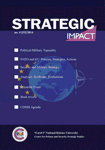IS HYBRID WARFARE SOMETHING NEW?
IS HYBRID WARFARE SOMETHING NEW?
Author(s): Crăişor Constantin IONIȚĂSubject(s): Security and defense, Military policy, Peace and Conflict Studies
Published by: Carol I National Defence University Publishing House
Keywords: hybrid warfare; hybrid threats; hybrid conflict; hybrid challenges; political warfare; compound wars;
Summary/Abstract: The question how the future conflict will look like seems to be the current preoccupation of many, if not of all Western military theoreticians. At the end of 1980’s, several military specialists launched the idea of the Forth Generation of Warfare (4GW), meaning the blurring nature of future conflict, especially the blurring of war and peace, as well as between combatants and noncombatants. The September 11th event of 2001 and the beginning of the Twenty-one Century came up with new concepts regarding the future of warfare, describing the rise of non-state willing and its possibility to be able to change the legitimacy of the state. New theories, like “new wars”, “compound wars”, “unrestricted warfare”, “robotic warfare”, “political warfare”, have been launched trying to capitalize the changes that occurred in the international security arena and in the diminishing of the international organization’s power to manage those situations. The Second Lebanon War of 2006 was the trigger that matched the views of many military analysts who have suggested that future conflicts will be multi-modal or multi-variant, by combining of increasing frequency and lethality. The new construct, known as the “hybrid warfare”, was exacerbated by the current crisis situation in Ukraine and the Russian intervention in Crimea and the Eastern Ukraine.
Journal: Strategic Impact
- Issue Year: 2014
- Issue No: 54
- Page Range: 61-71
- Page Count: 11
- Language: English

